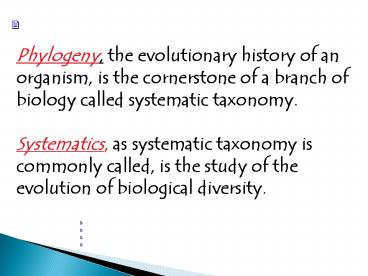Phylogeny, - PowerPoint PPT Presentation
1 / 10
Title:
Phylogeny,
Description:
Phylogeny, the evolutionary history of an organism, ... There are three basic assumptions in cladistics: Organisms within a group are descended from a common ancestor. – PowerPoint PPT presentation
Number of Views:169
Avg rating:3.0/5.0
Title: Phylogeny,
1
Phylogeny, the evolutionary history of an
organism, is the cornerstone of a branch of
biology called systematic taxonomy.
Systematics, as systematic taxonomy is commonly
called, is the study of the evolution of
biological diversity.
2
A phylogenetic tree is a family tree that shows a
hypothesis about the evolutionary relationships
thought to exist among groups of organisms. It
does not show the actual evolutionary history of
organisms. Why a hypothesis?
3
(No Transcript)
4
(No Transcript)
5
Phylogenetic trees are usually based on a
combination of these lines of evidence
Fossil record Morphology
Embryological patterns of development
Chromosomes and DNA
6
(No Transcript)
7
Cladistics - is a relatively new system of
phylogenetics classification that uses shared
derived characters to establish evolutionary
relationships. A derived character is a feature
that apparently evolved only within the group
under consideration.
8
- There are three basic assumptions in cladistics
- Organisms within a group are descended from a
common ancestor. - There is a bifurcating pattern of cladogenesis.
- Change in characteristics occurs in lineages over
time.
9
A phylogenetic tree based on a cladistic analysis
is called a cladogram. What derived character
is shared by all the animals on the cladogram on
the next slide?
10
(No Transcript)

